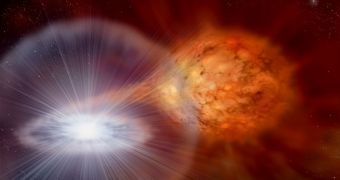The Hubble Space Telescope gets the 'Go Ahead' approval for the mission of observing the pending cataclysmic event of the variable star SDSS091908, due to studies made on the images taken by the Global Rent-a-scope Network. The research was made by the American Association of Variable Star Objects or AAVSO as requested by a team from the University of Washington, operating the Hubble Space Telescope.
Amateur astronomer Bill Dillon, former president of the American Association of Variable Star Objects, coordinated a team of amateur astronomers in the observation of the variable star SDSS091908, to determine if the event which will take place in the near future might pose any security problems to the Hubble Space Telescope, which is about to observe the two stars. Bill Dillon immediately launched a campaign to use the GRAS telescopes, equipped with mirror ranging from 25.6 to 38.4 centimeters in diameter, while the Hubble Space Telescope houses a mirror that has a diameter of 2.3 meters.
The SDSS091908 represents a variable star, better known as a binary star. The main component of the system is represented by a normal-sized star around which a pulsating white dwarf orbits, with an approximated diameter close to that of the Earth. The white dwarf is orbiting the other star so closely that the incredible gravitational pull of the white dwarf creates strips of gas drawn from the normal star. The gas spins around the white dwarf creating a so-called accretion disk.
The accretion disk around the white dwarf could become unstable and burn so bright that it would surpass the combined brightness of the two stars. So the Hubble Space Telescope previously measured the pulsation period of the white dwarf to provide crucial data for theorists to create a model of the white dwarfs' structure, thus determining how long the system will remain stable and emit low-brightness to ensure that the HST's sensitive instruments won't be damaged.
The campaign initiated by Bill Dillon involved using the multiple telescopes of the GRAS network to create round-the-clock observations on the binary system. With only five minutes before the decision to observe the SDSS091908 system, Dr Szokody received the approval to run observations with the Hubble, due to the fact that amateur astronomers conducting observations using GRAS decided that the star system would remain stable and will be in a low-brightness state, making it safe for Hubble observation.
This was the first time in history when amateur astronomers made a round-the-clock observation using a global network, in the past only available to professional astronomers. The GRAS spokesman reported that the total cost for the survey was only 50 US dollars, due to the incredible efficiency of the system.
The GRAS network is composed of a network of telescopes positioned all over the world in strategic time zones and equipped with CCD cooled cameras and special optical filters to promote round-the-clock observations. The network is also available to amateur astronomers who have no previous technical experience and includes some of the highest quality astronomical equipment in the world.

 14 DAY TRIAL //
14 DAY TRIAL //